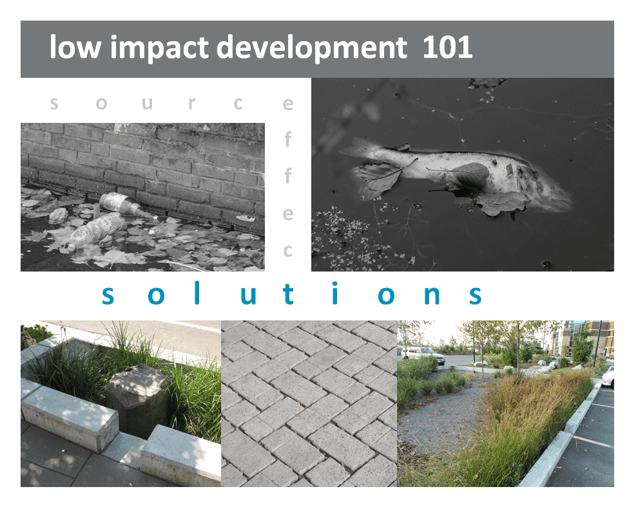 Previously in this series, we discussed the primary source of stormwater pollution and the effects that urban stormwater runoff is having on salmon throughout the Northwest. In summary, very few (about 25%) coho adult salmon are surviving long enough to spawn in urban creeks and only about 25% of hatched salmon embryos are surviving when raised in unfiltered water. With this post, we begin a series of posts discussing Low Impact Development (LID) solutions that can be used to minimize impacts to fish, starting with bio-retention.
Previously in this series, we discussed the primary source of stormwater pollution and the effects that urban stormwater runoff is having on salmon throughout the Northwest. In summary, very few (about 25%) coho adult salmon are surviving long enough to spawn in urban creeks and only about 25% of hatched salmon embryos are surviving when raised in unfiltered water. With this post, we begin a series of posts discussing Low Impact Development (LID) solutions that can be used to minimize impacts to fish, starting with bio-retention.
A strong link between urban stormwater toxicity and salmon mortality has been well documented [Feist et al., 2011]. The obvious solution is to treat urban stormwater before it reaches urban creeks to remove the elements in the stormwater that are toxic to fish and other aquatic life (research is on-going to determine exactly which components in urban stormwater are toxic). Stormwater treatment has been the subject of numerous studies, regulations, operations manuals, and published design manuals for over 25 years. Only recently, though (approximately the last 10 years), have LID techniques been proposed for treating urban stormwater runoff.
Can simple LID solutions be used to protect aquatic species from harmful urban stormwater? Based on the research to date, the answer is an emphatic “yes.”
Bio-Retention – A Highly-Effective Treatment Method
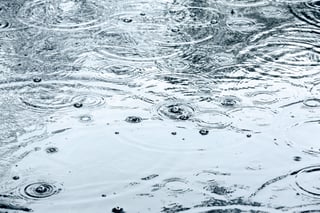 One particular LID technique is both simple and effective at treating urban stormwater runoff: filtrating stormwater through a layer of soil! Although this process (known as bio-retention) does not seem revolutionary, significant research has gone into determining the effectiveness of passing urban stormwater through a layer of soil in relation to protecting salmon and other aquatic life from the toxic constituents in the stormwater.
One particular LID technique is both simple and effective at treating urban stormwater runoff: filtrating stormwater through a layer of soil! Although this process (known as bio-retention) does not seem revolutionary, significant research has gone into determining the effectiveness of passing urban stormwater through a layer of soil in relation to protecting salmon and other aquatic life from the toxic constituents in the stormwater.
In one particular study [McIntyre, et al., 2014] juvenile salmon and their macroinvertebrate food (daphniid, cladocerans, mayfly) were exposed to one of three water conditions:
- control water (clean water)
- untreated urban stormwater from a Seattle arterial street
- urban stormwater that had passed through a mixed soil layer
The mixed soil layer consisted of 24 inches of 60% sand, 15% compost, 15% shredded bark, and 10% drinking water treatment residuals (suspended solids, organics, calcium carbonate, minerals).
The study results were quite profound. Macroinvertebrates (food that salmon prey on) exposed to untreated urban stormwater runoff experienced 80 to 100% mortality before reaching reproductive age. Macroinvertebrates exposed to the control water had 0% mortality.
The really interesting finding was, however, that macroinvertebrates exposed to urban stormwater that had been filtered through the bio-retention soil column had survival rates that did not differ significantly from the control –virtually no mortality.
Similarly, juvenile coho salmon exposed to untreated urban stormwater experienced 100% mortality within 12 hours; whereas juvenile coho salmon exposed to urban stormwater that had been filtered through the bio-retention soil column had no mortality.
Essentially, the bio-retention soil layer filtered the stormwater sufficiently so that it was no longer toxic to aquatic life! Filtering through the bio-retention soil resulted in a 30% to 99% reduction in metals, a reduction of > 92% in petroleum hydrocarbons, and organic matter reduction of over 40% [McIntyre et al., 2014]).
Practical Application
How can a layer of soil be used to remove stormwater toxicity? There are two specific LIDs that use a layer of soil to treat stormwater –rain gardens and bio-retention swales. Essentially, stormwater runoff is routed (typically by surface flowing) to shallow planted depressions where the stormwater is filtrated through an 18-inch thick layer of Bioretention Soil Media (generally defined as 60% loamy sand and 40% compost) before it is discharged to groundwater, a stream, or a storm system—see figure below.
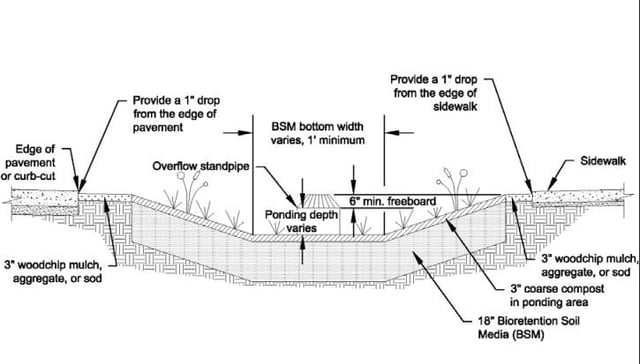
[Figure 7.4.1a Typical Bio-retention, 2012 Stormwater Management Manual for Western Washington, Amended December 2014, Department of Ecology, State of Washington]
The exciting news is that treating stormwater through a simple soil layer is non-proprietary and relatively inexpensive, while also being extremely successful at removing the toxicity from stormwater. These LID solutions can be easily incorporated into a wide range of projects and situations to treat stormwater: for new development or roadways these planted infiltration areas are simply designed into a site plan, and they can also be retrofitted into an existing roadway system or parking lot.
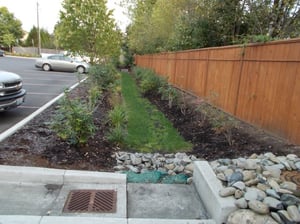 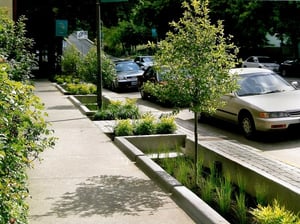 |
As you can see, sometimes simplicity is the best option.
It should be noted that there are a few situations when bio-retention should not be used for stormwater treatment, so look for our next post in this series when we will discuss on-going research associated with bio-retention, when it should not be used, and some of the other soil mediums being investigated.
We hope you use this series to educate your family, friends, and professional networks about stormwater impacts and how LID solutions can help solve them. Please share and get the word out!
References:


Leave us a comment below